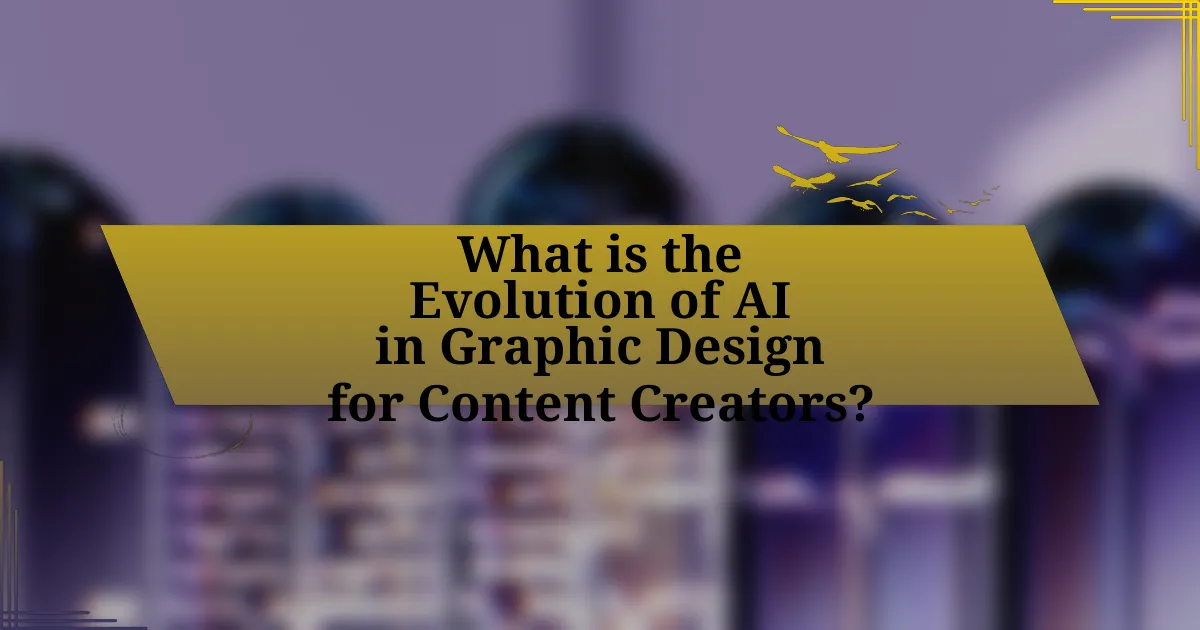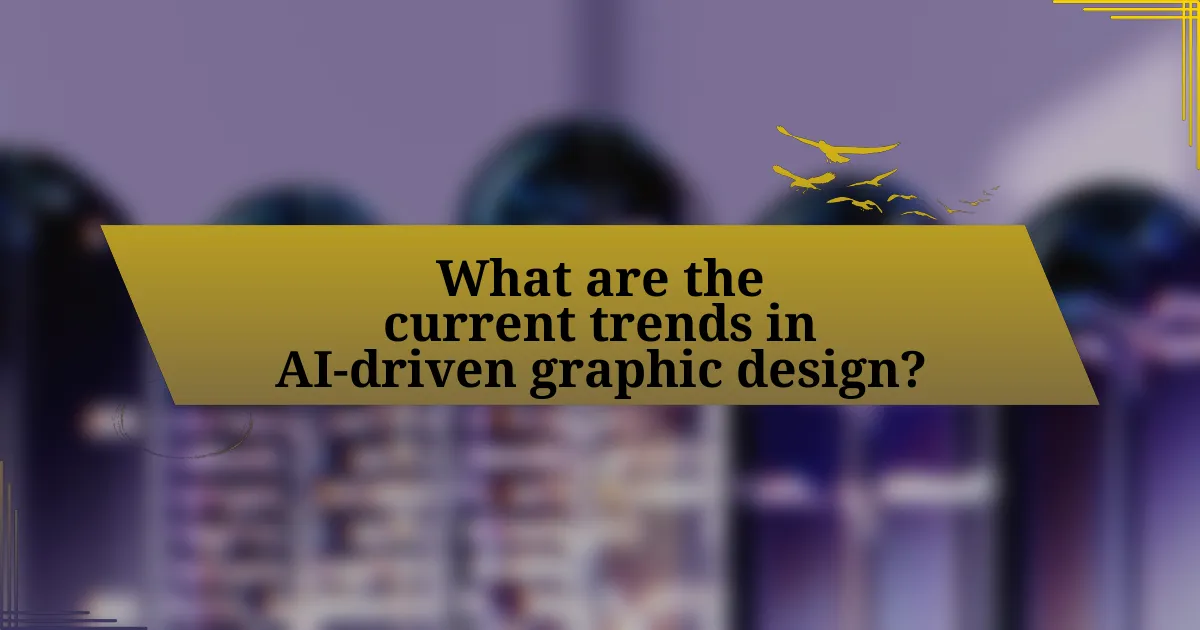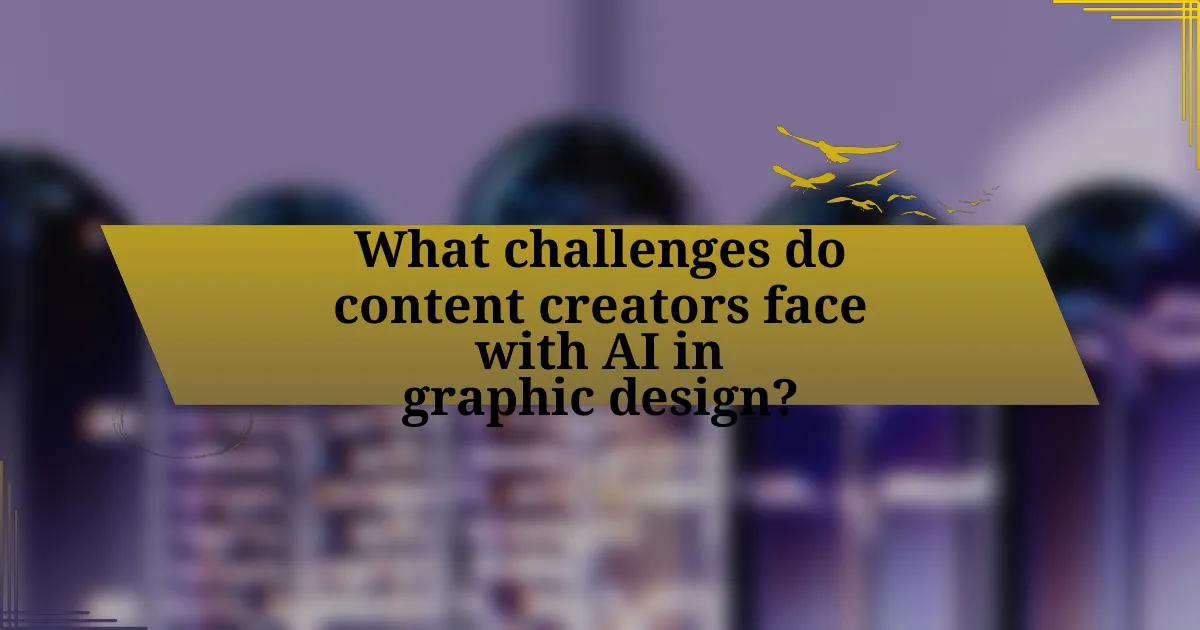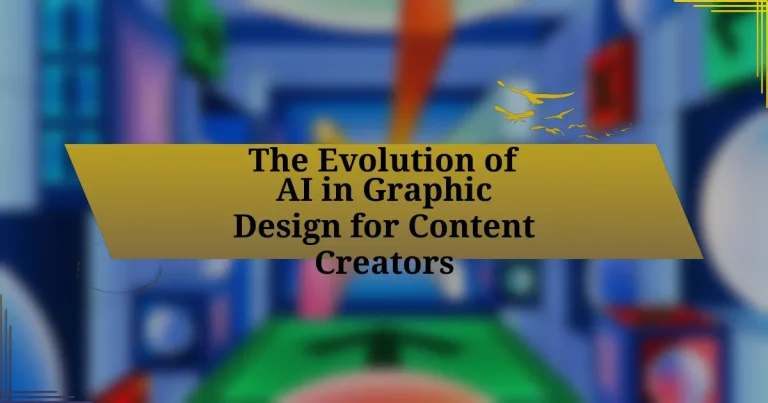The article focuses on the evolution of artificial intelligence (AI) in graphic design, particularly its impact on content creators. It outlines how AI has transformed the creative process by automating repetitive tasks, enhancing design workflows, and fostering innovation through tools like Adobe Sensei and Canva. Key milestones in AI development, such as the introduction of generative design and machine learning techniques, are discussed, highlighting their implications for productivity and creativity in design. Additionally, the article addresses the challenges and ethical considerations associated with AI in graphic design, emphasizing the importance of balancing creativity with AI assistance and the need for designers to adapt to these advancements.

What is the Evolution of AI in Graphic Design for Content Creators?
The evolution of AI in graphic design for content creators has transformed the creative process by integrating advanced algorithms and machine learning techniques. Initially, AI tools focused on automating repetitive tasks, such as resizing images and basic editing, which allowed designers to save time and increase efficiency. Over the years, AI has progressed to more sophisticated applications, including generative design, where algorithms can create unique design elements based on user-defined parameters.
For instance, Adobe’s Sensei utilizes AI to enhance design workflows by offering features like content-aware fill and automated tagging, which streamline the design process. Additionally, AI-driven platforms like Canva and Figma have emerged, providing content creators with intuitive tools that leverage AI for layout suggestions and design recommendations. This shift not only empowers content creators to produce high-quality graphics more rapidly but also democratizes design by making advanced tools accessible to non-professionals.
The impact of AI on graphic design is evidenced by a significant increase in productivity and creativity among users, as reported in various industry studies, highlighting a growing reliance on AI technologies in the design landscape.
How has AI technology transformed graphic design practices?
AI technology has transformed graphic design practices by automating repetitive tasks, enhancing creativity, and providing advanced tools for designers. Automation through AI tools like Adobe Sensei allows designers to focus on more complex aspects of their work, such as conceptualization and strategy, rather than mundane tasks like resizing images or color correction. Additionally, AI-driven design software can generate design variations and suggest layouts, which accelerates the creative process. For instance, tools like Canva utilize AI to recommend design elements based on user preferences, streamlining the workflow. This shift not only increases efficiency but also fosters innovation, as designers can experiment with new ideas without the constraints of traditional methods.
What are the key milestones in the evolution of AI in graphic design?
The key milestones in the evolution of AI in graphic design include the introduction of early algorithms for image processing in the 1960s, the development of generative design tools in the 1990s, and the emergence of machine learning techniques in the 2010s. In the 1960s, researchers began using algorithms to manipulate images, laying the groundwork for future advancements. The 1990s saw the rise of generative design software, enabling designers to create complex forms through algorithmic processes. By the 2010s, machine learning algorithms, particularly deep learning, revolutionized graphic design by automating tasks such as image recognition and style transfer, significantly enhancing creative workflows. These milestones collectively demonstrate the progressive integration of AI technologies into graphic design, transforming how designers approach their work.
How do these milestones impact content creation?
Milestones in AI development significantly enhance content creation by streamlining processes and improving efficiency. For instance, advancements in machine learning algorithms enable graphic design tools to automate repetitive tasks, allowing creators to focus on more complex and creative aspects of their work. Additionally, the introduction of AI-driven design software, such as Adobe Sensei, has been shown to reduce the time spent on design iterations by up to 50%, thereby accelerating project timelines. These milestones not only increase productivity but also foster innovation, as creators can leverage AI capabilities to explore new design possibilities and enhance their creative output.
Why is AI becoming essential for content creators in graphic design?
AI is becoming essential for content creators in graphic design because it enhances efficiency and creativity through automation and advanced tools. By automating repetitive tasks such as resizing images, generating layouts, and suggesting color palettes, AI allows designers to focus on more complex and creative aspects of their work. For instance, tools like Adobe Sensei utilize machine learning to analyze design trends and provide personalized recommendations, significantly speeding up the design process. Additionally, AI-driven platforms can generate unique design elements based on user input, enabling creators to explore a wider range of ideas and styles. This integration of AI not only streamlines workflows but also fosters innovation, making it a crucial component in modern graphic design.
What advantages does AI offer to graphic designers?
AI offers graphic designers enhanced efficiency, creativity, and personalization. By automating repetitive tasks such as resizing images, generating layouts, and suggesting color palettes, AI allows designers to focus on more complex and creative aspects of their work. For instance, tools like Adobe Sensei utilize machine learning to analyze design trends and provide intelligent recommendations, streamlining the design process. Additionally, AI-driven platforms can analyze user data to create personalized designs tailored to specific audiences, improving engagement and effectiveness. This integration of AI not only accelerates workflow but also elevates the quality of design outputs, making it a valuable asset for graphic designers.
How does AI enhance creativity and efficiency in design processes?
AI enhances creativity and efficiency in design processes by automating repetitive tasks and providing intelligent suggestions that inspire innovative ideas. For instance, AI tools can analyze vast datasets to identify design trends, enabling designers to create more relevant and appealing visuals. Additionally, AI-driven software can generate design variations quickly, allowing creators to explore multiple concepts without extensive manual effort. Research by Adobe indicates that designers using AI tools report a 30% increase in productivity, as these tools streamline workflows and reduce time spent on mundane tasks. This integration of AI not only accelerates the design process but also fosters a more creative environment by freeing designers to focus on higher-level conceptual work.

What are the current trends in AI-driven graphic design?
Current trends in AI-driven graphic design include the use of generative design tools, automated content creation, and personalized design experiences. Generative design tools leverage algorithms to create multiple design variations based on user inputs, allowing designers to explore a wider range of creative possibilities efficiently. Automated content creation utilizes AI to generate graphics, layouts, and even entire branding packages, significantly reducing the time required for design tasks. Additionally, personalized design experiences are becoming prevalent, where AI analyzes user data to tailor designs that resonate with specific audiences, enhancing engagement and effectiveness. These trends reflect the growing integration of AI technologies in the graphic design process, streamlining workflows and expanding creative potential.
How are AI tools being integrated into graphic design workflows?
AI tools are being integrated into graphic design workflows by automating repetitive tasks, enhancing creativity, and streamlining collaboration. For instance, software like Adobe Sensei utilizes machine learning to assist designers in tasks such as image editing and layout suggestions, significantly reducing the time spent on manual adjustments. Additionally, AI-driven platforms like Canva offer design templates and smart suggestions that cater to user preferences, enabling faster project completion. Research indicates that 70% of designers report increased efficiency when using AI tools, highlighting their impact on productivity and creative output.
What are the most popular AI tools used by content creators today?
The most popular AI tools used by content creators today include Canva, Adobe Sensei, Jasper, and Lumen5. Canva utilizes AI for design suggestions and layout optimization, making it user-friendly for non-designers. Adobe Sensei enhances creative workflows by automating repetitive tasks and providing intelligent editing features. Jasper is an AI writing assistant that helps generate content ideas and drafts, streamlining the writing process. Lumen5 leverages AI to transform text into engaging videos, catering to the growing demand for video content. These tools are widely adopted due to their ability to enhance productivity and creativity in content creation.
How do these tools improve the design process?
AI tools improve the design process by automating repetitive tasks, enhancing creativity, and providing data-driven insights. Automation allows designers to focus on more complex and creative aspects of their work, as AI can handle tasks such as resizing images, generating layouts, and suggesting color palettes. Enhanced creativity is achieved through AI’s ability to generate design variations and offer inspiration based on current trends. Additionally, data-driven insights help designers make informed decisions by analyzing user preferences and engagement metrics, leading to more effective designs. For instance, a study by Adobe found that 61% of designers reported increased productivity when using AI tools, demonstrating their significant impact on the design workflow.
What role does machine learning play in graphic design?
Machine learning significantly enhances graphic design by automating repetitive tasks, optimizing design processes, and providing data-driven insights. For instance, machine learning algorithms can analyze user preferences and trends, enabling designers to create more personalized and relevant content. Additionally, tools like Adobe Sensei utilize machine learning to streamline workflows, such as automatically tagging images or suggesting design elements based on context. This integration of machine learning not only increases efficiency but also allows designers to focus on more creative aspects of their work, ultimately leading to innovative design solutions.
How does machine learning enhance design personalization?
Machine learning enhances design personalization by analyzing user data to create tailored experiences. It processes vast amounts of information, such as user preferences, behaviors, and interactions, allowing designers to generate customized content that resonates with individual users. For instance, algorithms can identify patterns in user engagement, enabling the automatic adjustment of design elements like color schemes, layouts, and typography to better align with user tastes. Research indicates that personalized designs can increase user engagement by up to 50%, demonstrating the effectiveness of machine learning in creating more relevant and appealing graphic design solutions.
What are the implications of machine learning for future design trends?
Machine learning will significantly influence future design trends by enabling personalized and adaptive design solutions. As machine learning algorithms analyze user data and preferences, they can generate tailored design elements that resonate with individual users, enhancing user experience. For instance, Adobe’s Sensei uses machine learning to automate repetitive tasks and suggest design improvements, demonstrating how AI can streamline workflows and foster creativity. This shift towards data-driven design not only increases efficiency but also allows designers to focus on more complex and innovative aspects of their work, ultimately shaping a more user-centric design landscape.

What challenges do content creators face with AI in graphic design?
Content creators face several challenges with AI in graphic design, including a lack of creative control, potential job displacement, and the need for technical proficiency. The reliance on AI tools can limit a creator’s ability to express unique artistic visions, as these tools often generate designs based on existing patterns rather than original concepts. Furthermore, the increasing sophistication of AI may lead to concerns about job security within the graphic design industry, as automated solutions can perform tasks traditionally handled by human designers. Additionally, content creators must adapt to new technologies and learn how to effectively integrate AI into their workflows, which can require significant time and effort.
What ethical considerations arise from using AI in design?
The ethical considerations arising from using AI in design include issues of authorship, bias, and transparency. Authorship concerns stem from the question of who owns the rights to AI-generated designs, as traditional copyright laws may not adequately address creations made by algorithms. Bias in AI systems can lead to the perpetuation of stereotypes or exclusion of certain groups, as AI models are trained on existing data that may reflect societal biases. Transparency is crucial, as designers and users must understand how AI tools make decisions to ensure accountability and trust in the design process. These considerations highlight the need for ethical guidelines and frameworks to govern the use of AI in design, ensuring that technology serves all stakeholders fairly and responsibly.
How can content creators address potential biases in AI-generated designs?
Content creators can address potential biases in AI-generated designs by implementing diverse training datasets and conducting regular audits of AI outputs. Utilizing diverse datasets ensures that the AI learns from a wide range of perspectives, reducing the risk of perpetuating stereotypes or excluding underrepresented groups. Regular audits involve analyzing AI-generated designs for bias and making necessary adjustments to the algorithms or datasets. Research indicates that diverse training data can significantly improve the fairness of AI systems, as demonstrated in studies like “Fairness and Abstraction in Sociotechnical Systems” by Selbst et al., which highlights the importance of inclusive data in mitigating bias.
What are the risks of over-reliance on AI tools?
Over-reliance on AI tools poses significant risks, including reduced creativity, dependency on technology, and potential job displacement. When content creators depend heavily on AI for graphic design, they may experience a decline in original thought and innovation, as AI-generated outputs can limit the exploration of unique ideas. Additionally, this dependency can lead to a lack of critical skills, making creators vulnerable if AI tools fail or become obsolete. Furthermore, studies indicate that automation in creative fields could result in job losses, as AI systems increasingly take over tasks traditionally performed by humans, thereby threatening employment opportunities in graphic design.
How can content creators effectively adapt to AI advancements?
Content creators can effectively adapt to AI advancements by integrating AI tools into their workflows to enhance creativity and efficiency. Utilizing AI-driven software for tasks such as image generation, content curation, and audience analysis allows creators to streamline their processes and focus on higher-level creative decisions. For instance, platforms like Adobe Sensei leverage machine learning to automate repetitive tasks, enabling creators to produce high-quality designs more quickly. Additionally, staying informed about emerging AI technologies and trends through continuous learning and professional development ensures that content creators remain competitive in a rapidly evolving landscape.
What skills should designers develop to work alongside AI?
Designers should develop skills in data literacy, machine learning understanding, and collaboration with AI tools to work effectively alongside artificial intelligence. Data literacy enables designers to interpret and utilize data-driven insights for informed design decisions. Understanding machine learning principles allows designers to grasp how AI algorithms function, enhancing their ability to create designs that leverage AI capabilities. Collaboration skills are essential for integrating AI tools into the design process, ensuring that designers can effectively communicate and work with AI systems to enhance creativity and efficiency.
How can content creators stay updated with AI trends in graphic design?
Content creators can stay updated with AI trends in graphic design by regularly following industry-specific publications, attending webinars, and participating in online communities. Industry publications such as “Wired” and “Fast Company” frequently cover advancements in AI technology and its applications in design. Webinars hosted by design software companies like Adobe and Canva often showcase the latest AI tools and features. Additionally, online communities on platforms like Reddit and Discord provide real-time discussions and insights from peers and experts, helping creators stay informed about emerging trends and best practices.
What best practices should content creators follow when using AI in graphic design?
Content creators should prioritize ethical considerations, data privacy, and creative originality when using AI in graphic design. Ethical considerations involve ensuring that AI-generated content does not infringe on copyright or intellectual property rights, as misuse can lead to legal repercussions. Data privacy is crucial; creators must ensure that any data used to train AI models complies with regulations like GDPR, protecting user information. Additionally, maintaining creative originality is essential; creators should use AI as a tool to enhance their unique style rather than relying solely on it, as over-dependence can dilute personal creativity. These practices help foster responsible and innovative use of AI in graphic design.
How can designers balance creativity and AI assistance?
Designers can balance creativity and AI assistance by leveraging AI tools to enhance their creative processes while maintaining their unique artistic vision. By using AI for repetitive tasks, such as generating variations or automating design elements, designers can free up time to focus on innovative concepts and personal expression. Research indicates that 70% of designers report increased productivity when using AI tools, allowing them to explore more creative avenues without being bogged down by mundane tasks. This synergy between human creativity and AI efficiency fosters a collaborative environment where both can thrive, ultimately leading to more original and impactful designs.
What strategies can enhance collaboration between human designers and AI tools?
To enhance collaboration between human designers and AI tools, integrating iterative feedback loops is essential. This strategy allows designers to provide continuous input on AI-generated outputs, refining the results to better align with creative visions. Research indicates that iterative processes improve design quality, as seen in studies where user feedback significantly enhanced AI performance in design tasks. Additionally, establishing clear communication channels between designers and AI systems fosters a better understanding of design goals, leading to more effective collaboration.

